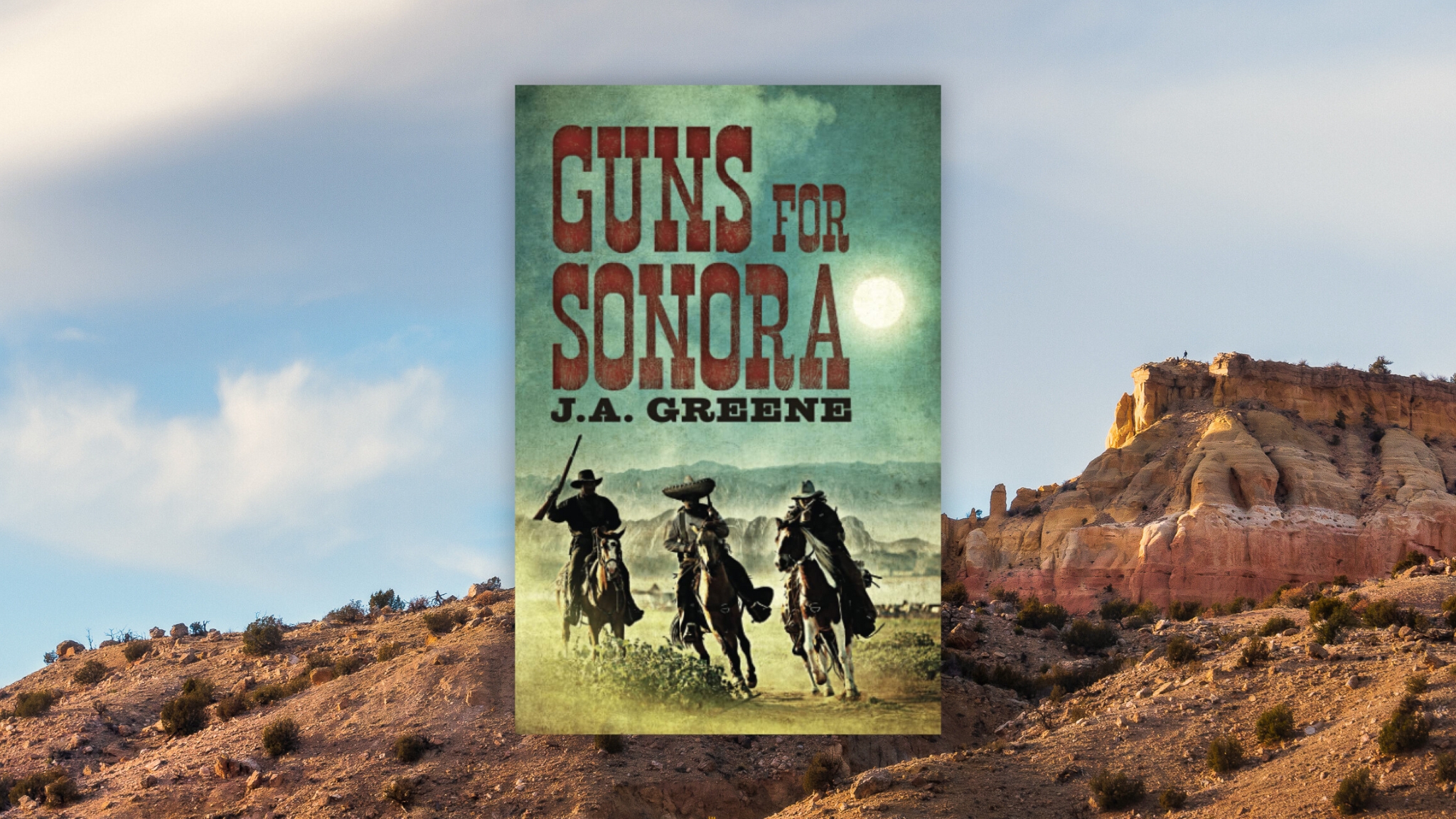Guns for Sonora by J. A. Greene
What's It About?
A vibrant account of a soldier-turned-gunrunner fighting for his fair share and survival in the American southwest of the 1880s.J. A. Greene’s vivid debut novel Guns for Sonora paints late-19th-century life in the southwestern United States with a visceral sensibility that brings the era to life. The novel spans two years, from 1887 to 1889, and takes place in what was then the U.S. territory of Arizona and the Mexican state of Sonora. The 40-something protagonist is Connor, a former U.S. soldier-turned-mule-packer who runs guns and ammunition across the border through heat-scorched desert and mountains, facing greedy government officials at one turn and desperate outlaws at the next. Connor is a self-confident realist, “not fearless, … rather a fatalist … trusting his survival chances to emerge maybe not unscathed, but alive.” His dexterous gun skills and bravery in saving himself and others are put to the test on every page.
An Activist’s Murder Forebodes Bloody Conflict
As background to the story, historic events have recently transformed the Sonora-to-Tucson region. Thirty-some years of intense Apache wars end in 1886 as the much-feared Apache leader Geronimo is captured in Sonora and sent off to Florida. The Pacific railroad finally crosses the border in the mid-1880s, making Tucson the northern gateway to Sonora and Mexico. The new rail opens access to some of Sonora’s most fertile land along the Yaqui River, land that the rural Yaqui tribe has farmed since before Spanish explorers first arrived in 1553.
In April 1887, beloved Yaqui activist Cajeme — who taught himself Spanish, enjoyed an exemplary career in the Mexican Army and now leads the Yaqui push for self-government — is killed. In the face of Mexican government efforts to attract commercial investment to this rich soil, Yaquis enlist everyone they can to push back. Connor sees the Yaquis as semi-civilized farmers and he is among those who support their interests, even as their submission, exile and death appear likely.
Danger at Every Turn
As the story begins Connor has just purchased land in the copper-mining town of Clifton, Arizona, and plans to settle down as soon as the Apaches do. In the meantime he has hired himself out as gunrunner and mule-packer for small groups bringing weapons over the border to the Yaqui tribe in Sonora. The novel opens with a rush as Connor gets caught in an ambush. Rolling down a steep hill to avoid getting stomped by a herd of panicked animals, he hits a scrub juniper tree with a “brutal, rib-cracking jolt” and it’s not looking good. “Right side ripped and raw, ripping pain sawing at his heart, Connor lay stunned.” This is page three of a story where pacing does not let up. Risk from competitors, enemies and the vigilant Mexican customs and border police — aka the Rurales — climbs to a crisis level as the story continues.
Connor attempts to keep his wits about him as he delivers the goods and enjoys the occasional company of a woman he fancies but does not trust. In addition to picking an historical era of tumult to set the story, Greene deepens it with a few colorful real-life heroes. Emilio Kosterlitzky — a Russian-born soldier known famously as the Mexican Cossack who served in the Mexican-Apache and Yaqui wars — now heads the Rurales. Both Conner and his gun-runner competitor and nemesis Isaac Walker served as soldiers under real-life Civil War officers of historical note.
A Hero Worth Rooting For
Details of the pragmatic elements of a life on the run put us squarely into the frontier world of the 1880s. A pint flask of rye whiskey becomes antiseptic for wounds, painkiller for cutting out bullets and reducing pain, and entertainment in the rare moments that invoke celebration. Clothing gets torn into strips to bind wounds. Dinner consists of cans of pears and pinto beans hauled in leather and fabric holders by the mules. Pistol-cleaning kits double as tools to dig out bullets. Rare moments of pleasure include nightcaps of Bacanora, a high-proof mescal made from an agave cactus native to Sonora. Guns — to include spare parts, the tools to clean them and design of the holders from which they are accessed with not a second lost — are Connor’s primary focus for keeping himself alive.
On a larger scale, Guns for Sonora makes us consider how a century and a half later, the era of gun-running and land-grabbing may be passed but we still fight over the same limited resources of land and water and the power to control them. Our modern-day life at times feels no less contentious. A pragmatic and unflappable hero like Connor — able to bandage his own wounds, keep his expectations realistic and stick to his principles of fairness and doing the right thing in his small part of the globe — offers role-model material. With such principles intact we can all strive to do the right thing in our own neighborhoods.
 J.A. Greene is a US Army, Infantry veteran with over ten years active duty and another twelve in the US Army Reserve. He has taught Military History at Arizona State University while part of the Military Science Department there. His interest in Southwestern history, and in particular, the final years of the 19th Century inspired him to begin this series. J.A. Greene has worked in the Four Corners area of the Southwest commanding a detachment of the US Army Reserves. He has visited Forts Wingate, Lowell, Whipple, Huachuca and other Posts that feature in the settlement of the region. He has worked for several Fortune 500 companies as an Operations Executive specializing in Manufacturing. He currently lives in Arizona where he is working on his second novel of this series.
J.A. Greene is a US Army, Infantry veteran with over ten years active duty and another twelve in the US Army Reserve. He has taught Military History at Arizona State University while part of the Military Science Department there. His interest in Southwestern history, and in particular, the final years of the 19th Century inspired him to begin this series. J.A. Greene has worked in the Four Corners area of the Southwest commanding a detachment of the US Army Reserves. He has visited Forts Wingate, Lowell, Whipple, Huachuca and other Posts that feature in the settlement of the region. He has worked for several Fortune 500 companies as an Operations Executive specializing in Manufacturing. He currently lives in Arizona where he is working on his second novel of this series.





